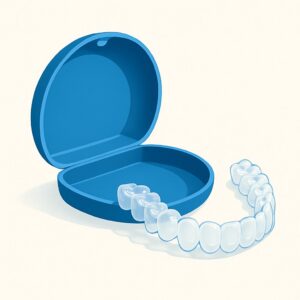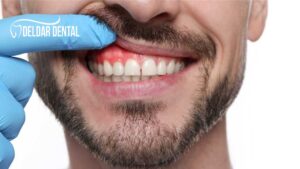The temporomandibular joint (TMJ) is also known as the jaw joint. It consists of two matching jaw joints in front of the ears and on side of the head. It connects the lower jaw to the skull and allows the jaw to move up, down, and side to side. TMJ disorders are essentially painful. Chronic degenerative disorders causing unnecessary discomfort are affected by TMJ dysfunction.
Learning how you can recognize the signs and symptoms associated with TMJ disorders can help alleviate the pain can make a difference in your life or the lives of your loved ones affected by TMJ problems. Below are the most important 5 things you should know about TMJ.
1. Signs and Symptoms of TMJ dysfunction
People suffering from TMJ problems can experience symptoms that typically include:
- jaw pain ( from dull pain that comes and goes, to more severe, constant and chronic pain) and spasms of the jaw muscles
- pain in the chewing muscles, pain in front of or around the ears, in the neck, shoulders and face
- limited movement of the mouth or locking up of the jaw, with negative effects on mastication ( difficulty chewing) and speech
- grating, popping or clicking sounds when opening the mouth
- ringing in the ears ( or tinnitus), headaches or migraines, toothaches, earaches and other types of facial pain
- hearing problems, dizziness or vertigo and numbness.
2. The Main Causes of TMJ Disorders
TMJ dysfunction is commonly caused by malocclusion (a bad bite or bite out of alignment). In some cases, TMJ dysfunction can also be caused by the following.
- injuries or trauma to the temporomandibular joint or the lower jaw
- anxiety/ stress and more specifically grinding or clenching the teeth that adversely affect the jaw muscles and lead to jaw/orofacial pain
- wearing away of the cartilage or the disk in the temporomandibular joints due to various health issues or aging
- tooth extraction and dental restorations that fail to take the jaw joints and muscles into account.
3. The Risk Factors for TMJ dysfunction
Age, gender, poor posture, neurodegenerative diseases, malocclusion and jaw misalignment are among the risk factors. High stress levels ( especially over a prolonged period of time), insomnia, depression, anxiety and bad habits such as clenching the lower jaw or grinding the teeth also considerably increase the risk of TMJ disorders. Children and teenagers suffering from osteoarthritis or rheumatoid arthritis as well as people with ages between 30 and 50 and women in particular are typically exposed to a significantly higher risk of developing TMJ-related problems.
4. The Lifestyle Changes That Can Help Prevent or Reduce the Symptoms
A self-care regimen is an intrinsic part of the treatment plan for TMJ dysfunction and encompasses several lifestyle changes that once implemented, can prove helpful in alleviating the symptoms or decreasing their severity. These lifestyle changes include:
- changing the eating habits i.e. cutting food into smaller pieces to avoid prolonged chewing, eating soft foods, avoiding chewing gum
- exercising a few times per week to enhance the ability of handling pain; to avoid jaw dislocations or fractures, it is recommended to use safety equipment while exercising
- learning and practicing stress-reducing and relaxation techniques; cognitive behavioral therapy can also help manage stress, tension and anxiety which increase the susceptibility to teeth grinding and jaw clenching
- improving your posture can also help reduce jaw pain
- learning how to correctly stretch, massage and relax the muscles around your lower jaw; your neuromuscular dentist can help you with these exercises.
5. The Treatment Options For TMJ Dysfunction
TMJ treatment options encompass non-invasive procedures aimed at correcting the bite and bringing the lower and upper jaw into alignment. These corrective treatments are performed by a dentist that specializes in neuromuscular dentistry, a branch of dentistry that focuses on properly correcting an imbalanced bite and realigning the jaw in order to create a harmonious functional relationship between the facial muscles, bite position and joints. The treatments that your neuromuscular dentist may recommend include :
- oral splint or orthotic therapy – the soft occlusal splint therapy is a more effective and safer treatment than invasive procedures such as surgical therapy. Its goal is to protect the temporomandibular joint discs from dysfunctional forces, improve jaw muscle function and relieve jaw pain by creating a balanced, stable occlusion.
- functional orthodontic correction aimed at restoring the teeth to their correct positions and improving the alignment of the lower and upper teeth
- TENS, laser and/or infrared therapies
- neuromuscular massage
- botox therapy, which can help prevent jaw clicking as well as treat chronic migraines,
- partial or full-mouth restoration for long-term stabilization of the temporomandibular joints, in the case of patients with more permanent changes to the bite and severe imbalance of the joints, muscles and nerves.
Care for your jaw joint
If you or a loved one have been experiencing jaw pain or facial pain, headaches, dizziness or any of the symptoms listed above, then do not hesitate to schedule a free consultation.
You can learn how you can benefit from a proper diagnosis and treatment plan devised by a certified, trusted and highly respected neuromuscular dentist and that is specifically aimed at providing pain relief, restoring the function of the muscles and joints and overall improving quality of life.




